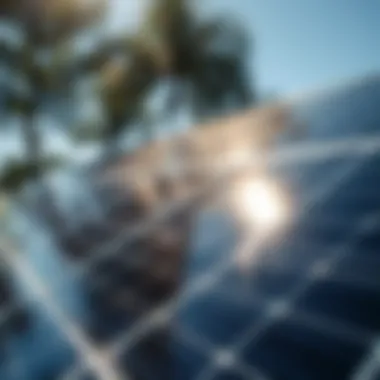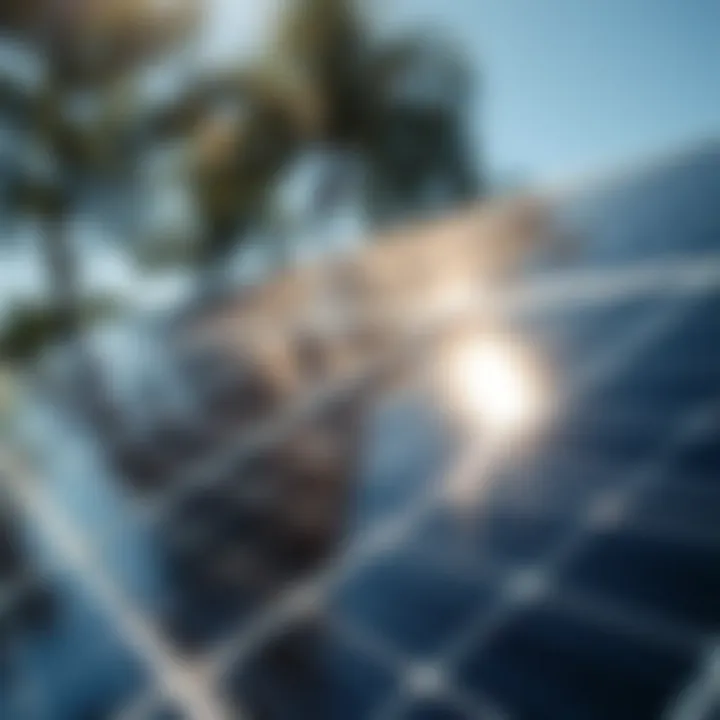A Comprehensive Guide to Buying Solar Panels


Intro
Purchasing solar panels can seem as overwhelming as trying to navigate a maze blindfolded. Yet, understanding the buying process is crucial for making informed decisions that can affect both your finances and your environmental footprint. The growing interest in renewable energy is not just a trend; it's a shift towards sustainable living, and solar energy is right at the forefront of this movement.
Many factors influence a decision to invest in solar energy—from rising electricity costs to the desire to reduce one’s carbon footprint. However, understanding the types of solar panels available and the financial implications can significantly impact your choice.
In this comprehensive guide, we’ll walk through the vital aspects of purchasing solar panels, highlighting key financial terms, expert tips, and much more. It’s not simply about plunking down cash and hoping for the best. Rather, it’s about making educated choices that align with your energy needs and budget.
Key Financial Terms
Understanding financial terms is a game changer for anyone diving into solar panel purchases. Let’s break down some essential jargon that will keep you ahead of the curve.
Definitions
- Photovoltaic (PV) Systems: These systems convert sunlight directly into electricity. They’re the workhorses behind your solar energy production.
- Net Metering: A billing arrangement that allows solar panel users to receive credit for the energy they contribute back to the grid. This can offset costs substantially.
- Incentives: Financial aids or tax credits offered by governments or organizations that can reduce the overall cost of solar panel installations.
Examples of Use
- Understanding net metering could help you gauge potential savings on your energy bill after installation.
- Being aware of different incentives can significantly reduce the upfront cost, making solar energy accessible to a broader audience.
Expert Tips
When it comes to purchasing solar panels, there are strategies that can guide both novices and veterans alike.
Beginner Strategies
- Research Providers: Don’t settle for the first deal that comes your way. Compare different companies and their reviews. It's often said, "good things come to those who wait"—so take your time!
- Evaluate Your Energy Needs: Look at your past energy consumption. This can guide you in selecting the right system to meet your specific energy requirements.
Advanced Techniques
- Consult with Experts: Use your networking skills. Speak with specialists in solar energy to get tailored advice that aligns with your particular circumstances. They can offer insights that you might never have considered.
- Understand the True Costs: Look beyond the sticker price. Factor in maintenance costs, potential upgrades in your home, and lifespan of the panels when calculating your return on investment.
Investing in solar panels isn't just a purchase; it's a commitment to a more sustainable future. Understanding the financial nuances and evaluating different systems is crucial for maximizing both savings and efficiency.
Prelims to Solar Energy and Its Benefits
The urge to harness solar energy is becoming increasingly prominent as individuals and communities recognize the vast potential that lies in sunlight. It's not just about saving a few bucks on electricity bills; it's about stepping into a green future where energy is cleaner and more sustainable. When we talk about solar energy, we enter a realm where the sun transforms from a distant star into a reliable energy source, shedding light on more than just our homes.
Overview of Solar Energy
Solar energy is fundamentally the harnessing of sunlight to generate electricity or heat. This process involves converting sunlight into usable energy through technologies like photovoltaic cells. The beauty of solar energy is its abundance; every hour, the sun provides enough energy to satisfy global energy needs for an entire year. Imagine the impact if more people leaned into this natural power instead of relying solely on fossil fuels.
There are several types of solar technologies available, each with its own applications. Solar thermal systems, for instance, can efficiently heat water, while photovoltaic panels generate electricity for residential and commercial use. The implementation of these technologies symbolizes a shift towards renewable resources that can help mitigate climate change and foster energy resilience.
Key Advantages of Solar Panels
Solar panels come with an array of benefits. Here are some noteworthy advantages that make them an appealing option for many:
- Savings on Electricity Bills: Once installed, solar panels significantly lower or even eliminate electricity bills. It’s like having a free ride on the energy highway.
- Environmental Impact: Using solar energy reduces reliance on fossil fuels, cutting down greenhouse gas emissions. It’s a step towards preserving our planet for future generations.
- Energy Independence: Generating your own power means you aren't solely dependent on your local utility company. This kind of self-sufficiency is increasingly valued in today’s unpredictable energy market.
- Increased Property Value: Homes equipped with solar panels often see a boost in property value. It’s not uncommon for prospective buyers to consider solar as a major selling point.
- Government Incentives: Many governments offer incentives for going solar, which can offset the initial setup costs. These incentives make the transition smoother and more financially appealing.
"Investing in solar technology is not merely an environmental decision—it's an economic strategy in today's volatile marketplace."
In essence, transitioning to solar energy is not just a trendy decision; it's a pragmatic and foresighted step into a sustainable future. As we delve deeper into the factors influencing the decision to purchase solar panels, we will unpack the motivations that drive individuals to embrace this innovative energy solution.
Factors Influencing the Decision to Purchase Solar Panels
Choosing to invest in solar panels isn't simply a transaction; it's a commitment to a lifestyle and attitude towards energy consumption. The decision involves weighing various elements that can significantly sway the final choice. From eco-friendly motives to the allure of economic benefits, several factors play a crucial role in this decision-making process. Understanding these elements allows prospective buyers to make informed choices about solar energy, a step towards both personal fulfillment and environmental stewardship.
Environmental Considerations
The spotlight on environmental issues is brighter than ever. With climate change becoming an unavoidable reality, many see the switch to solar energy as a critical step in reducing their carbon footprint. Solar panels help to generate clean, renewable energy, which directly contributes to lesser greenhouse gas emissions compared to fossil fuel-based power sources.
Moreover, investing in solar energy reflects an individual's commitment to protecting the planet. By harnessing sunlight, one contributes towards reducing pollutant levels and conserving natural resources.
Interestingly, integrating solar technology can lead to less reliance on non-renewable energy sources, which in turn fosters a healthier ecosystem. Think about it: every solar panel installed is a baby step towards a greener world.
Economic Incentives
When it comes to the nitty-gritty of financial aspects, the benefits of investing in solar can become quite enticing. Numerous states and local governments provide incentives aimed at promoting greener alternatives. These can include grants, rebates, and tax credits. For instance, the Federal Investment Tax Credit (ITC) allows homeowners to deduct a significant percentage of solar installation costs when filing taxes, which can lower the initial financial burden.
Additionally, many utility companies offer net metering options that let you sell excess energy produced back to the grid. This can lead to significant savings on utility bills, making solar panels not just an environmentally wise choice but also a financially savvy one.
Of course, the specifics may vary widely by location. It’s crucial to do a little homework on local incentives which could sweeten the deal. To sum it up, going solar not only clears the air literally but can also lift a financial weight off your shoulders.
Energy Independence


Energy independence is a phrase tossed around quite a lot, but its implications strike a chord for many. Transitioning to solar energy can lead to a reduced dependency on foreign oil and volatile fossil fuel markets. This independence promotes stability not just on a personal level, but can also ripple out to community and national levels.
Homeowners with solar panels installed are less exposed to market fluctuations, often bringing peace of mind. Gone are the days of stress over rising energy costs! In essence, having solar panels means that a portion of your energy needs are met by harnessing the sun’s rays, turning you into a small-scale energy producer.
Embracing solar energy fosters a sense of autonomy in energy use. It’s empowering to know that you have taken a stand against the conventional energy system, contributing to a sustainable future while enjoying the financial freedom that comes alongside it.
“Going solar is not just a home improvement; it’s an investment in your future.”
Types of Solar Panels Available in the Market
The market is brimming with choices when it comes to solar panels, making it essential to understand the various options available. Each type of solar panel comes with its own set of benefits and considerations that can significantly affect your decision-making process. By knowing what’s out there, a buyer can match their desires and needs with the right technology. Not only does this knowledge empower you, but it also ensures that your investment yields the maximum returns over time.
Monocrystalline Solar Panels
Monocrystalline solar panels are often touted as the premium choice among solar technologies. They are made from a single crystal structure, which gives them their distinctive black appearance. One key advantage is their high efficiency: they convert sunlight into electricity with impressive effectiveness, usually hovering around 15-22%. With a smaller surface area required for the same energy generation compared to others, they can be ideal for homes with limited roof space.
However, the price tag is also on the heftier side. If you are serious about getting the most out of your investment and plan on staying in your home for many years, this type of panel might be worth it. Another factor to weigh is their longevity. Monocrystalline panels tend to have a longer lifespan, often around 25 years or more, making them a reliable option.
Polycrystalline Solar Panels
Polycrystalline solar panels can be viewed as the more budget-friendly choice. The manufacturing process involves melting multiple crystals together, which is less expensive than the single-crystal approach. They typically have slightly lower efficiency—around 13-16% which might make you require a bit more roof space to generate comparable power levels.
While they aren’t as space-efficient as monocrystalline panels, they usually come at a lower cost, making them a good choice for those just starting their solar journey. On the downside, polycrystalline panels can be less efficient in high-temperature scenarios, which is something to consider based on your local climate. Some might say that they have a bluish hue, which can affect the aesthetic appeal if looks are a top priority for you.
Thin-Film Solar Panels
Thin-film solar panels represent a markedly different approach to solar technology. These panels are created by layering photovoltaic material onto a substrate like glass or metal. One significant advantage here is their lightweight nature—which can make installation easier.
In terms of efficiency, they fall behind the crystalline types, generally only achieving about 10-12% efficiency. However, they perform better in low-light conditions and at higher temperatures, making them ideal for certain environments. Somewhere in this niche market, you might find buyers who prioritize flexibility because thin-film panels can conform to various surfaces—this could even include curved roofs.
Ultimately, the choice boils down to your energy needs, budget, and installation conditions. Familiarizing yourself with these options will put you one step closer to making an informed decision about your solar investment.
Assessing Your Energy Needs
Assessing your energy needs is a critical step when considering the purchase of solar panels. Understanding your energy requirements does not just make the process smoother; it ensures that the system you invest in meets your actual needs without overspending. This evaluation is essential in tailoring a solar solution that maximizes efficiency and return on investment.
Conducting an Energy Audit
A comprehensive energy audit serves as the cornerstone of understanding your energy needs. It involves a thorough examination of your current energy use patterns. Here’s how to approach it:
- Gather the Data: Start by collecting your utility bills from the last year. Look for patterns and note peak usage periods, so you can identify areas for adjustment.
- Inspect Appliances: Take a closer look at each major appliance, from your refrigerator to heating and cooling systems. Identify how much energy each one consumes and consider efficiency ratings.
- Consider Lifestyle: Think about how lifestyle changes could affect your energy consumption. If you plan to grow your family, work from home more, or add electric vehicles, these factors should be included in your analysis.
The energy audit culminates in a clear picture of how much energy you use and when. This knowledge empowers you to choose a solar solution that meets your current and near-future needs.
Estimating Future Energy Consumption
Once you've completed your energy audit, projecting your future energy consumption becomes paramount. Here are the steps to achieve a reliable estimate:
- Extrapolate Current Data: Look at your past usage data and identify trends. Are there seasonal fluctuations? Understanding these variables helps build a realistic model of future needs.
- Plan for Growth: Account for foreseeable changes in your living situation or energy demands. If you anticipate installing electric vehicle chargers or upgrading to energy-hungry appliances, factor those into your estimations.
- Consult with Experts: Engaging with energy professionals can shed light on trends you might not have considered. They can provide benchmarks and insights tailored to your specific area and lifestyle.
By taking the time to assess both current and future energy needs, you're not just preparing to buy solar panels. You're making an informed investment that can significantly enhance your energy independence and sustainability.
"Being proactive about your energy needs today sets the stage for savings tomorrow."
In summary, both conducting a detailed energy audit and estimating future consumption are integral components of assessing your energy needs. This thorough understanding helps ensure that your solar panel system functions efficiently long after installation.
For further insights into energy audits, you can visit Energy.gov which provides extensive resources on energy conservation and usage.
Steps in the Solar Panel Purchasing Process
The purchasing process for solar panels is a significant journey that can seem daunting at first, but understanding it is crucial for making a sound investment. As the demand for renewable energy sources increases, navigating through the steps of selecting and buying solar panels becomes paramount. These steps not only help you to ensure you’re getting the right system for your needs, but also maximize the return on investment. This section will break down the necessary steps, highlighting key elements and considerations along the way.
Research and Information Gathering
Before diving into any big purchase, doing your homework is essential, and solar panels are no exception. The first step is opening that can of worms known as research. It’s about gathering as much information as you can regarding solar energy, the various types of panels available, their efficiencies, and how they might work for your home or business.
- What types of solar panels are on the market today?
- What differences are there in efficiency and cost?
- How do local weather and energy needs influence your choice?
Reading articles, going through manufacturers’ websites, and scouring forums like https://www.reddit.com/r/solar can provide a wealth of insights. Tapping into resources such as government websites, like the Department of Energy https://www.energy.gov/ and reputable solar energy blogs can further cement your understanding. This process of research not only arms you with knowledge but also empowers you to ask the right questions later in the process.
Obtaining Quotes and Comparing Options
With solid research under your belt, the next step is obtaining multiple quotes. This is where you really want to outline the potential costs and services each provider offers. Don’t just settle for the first quote that lands on your desk. Instead, reach out to at least three reputable installers in your area to get a varied perspective.
When comparing quotes, consider these elements:
- Installation Costs: How much does each company charge for the installation services?
- Equipment Quality: What brands of solar panels are included? Are they well-reviewed products?
- Maintenance Plans: Are there options for ongoing maintenance or warranties included in the quote?
- Timelines: How long will each installation take?


It’s essential not only to compare prices but also to weight the value of what you’re getting for those costs. Sometimes, the cheaper option may not always deliver the best outcome in the long run.
Evaluating Installer Credentials and Reviews
Once you have a handful of quotes, the focus should shift toward the installers themselves. This aspect of the purchasing process can often slip under the radar, but it’s critical for ensuring a successful installation. Scrutinize their credentials: Are they licensed and insured? Check for certifications from organizations like the North American Board of Certified Energy Practitioners (NABCEP).
Next, take a peek at customer reviews. Websites like https://www.yelp.com/ or https://www.google.com/maps can be gold mines for real user feedback. Look for patterns in the reviews. Are there repeated praises or complaints? This can speak volumes about their reputation and reliability.
Moreover, reach out for references and don’t hesitate to contact past clients. Ask questions about their experiences, satisfaction, and if the installer followed through on promises. When you know the credentials and reliability of your installer, it provides an extra layer of confidence in making such an important investment.
"Knowledge is power; if you think you know it all, you’re already on the path to making poor choices."
Taking the time to invest in this part of the process often pays dividends down the line, ensuring not just satisfaction, but potentially longer-lasting benefits from your solar panel system.
Understanding the Financial Implications of Solar Panel Installation
Solar panel installation represents not just an energy transition, but a substantial financial decision. Understanding the financial implications is crucial for making an informed choice that aligns with both immediate budget constraints and long-term financial goals. Investing in solar technology requires thorough consideration of various costs, financing options, available incentives, and ultimately, how these factors affect your return on investment.
Navigating these waters can feel like a tricky maze, but digging into the details unfolds a clearer path—one that could potentially lead to a more sustainable financial future.
Initial Costs and Financing Options
When diving into the ocean of solar panel purchase, the initial costs can often feel daunting. The expense of buying solar panels varies significantly, influenced by numerous factors including system size, panel type, and installation specifics. On average, homeowners in the U.S. might find themselves looking at an upfront investment ranging from $15,000 to $30,000 before considering state and federal incentives.
Here are some influencing your upfront costs:
- Panel Type: Different types of solar panels, like monocrystalline or polycrystalline, come with unique price points. Monocrystalline panels are typically more expensive but offer higher efficiency, which might save you money in the long run.
- Installation: Labor costs often contribute a large chunk of the budget. Hiring reputable installers can increase your short-term costs but mitigate future issues.
- System Size: Generally, more power requires more panels, thus higher costs.
Fortunately, financing options have become more approachable, helping to ease the financial burden. Many homeowners opt for:
- Solar Loans: These can come from banks or specialized lenders, allowing for manageable long-term payments.
- Leases: Leasing options let you use solar energy without a hefty upfront cost, though they usually lock you into a longer-term payment.
- Power Purchase Agreements (PPAs): Here, you pay for the energy produced rather than the panels themselves, often leading to no upfront costs.
Navigating these options with due diligence can light the way toward greater affordability.
Government Incentives and Tax Benefits
The financial landscape of solar investment is further sweetened by various government incentives that can make your investment far more manageable. Federal and state-level incentives are designed to promote clean energy and can reduce your tax burden significantly.
An important point to note is that the Federal Solar Investment Tax Credit (ITC) allows you to deduct a percentage of the cost of installing a solar energy system from your federal taxes. As the current ITC stands at 26%, anyone investing in solar panels might find their overall expenditure drastically slashed.
Additionally, many states offer specific rebates that can directly lower initial costs or provide property tax exemptions for solar-enabled homes. It’s good practice to check local laws and incentives that might be available in your area—this could lead to significant savings.
Calculating Return on Investment
One of the most critical steps in understanding your solar investment involves calculating the return on investment (ROI). This metric provides insight into how quickly your investment pays for itself and when you can expect to see actual savings.
To gauge your ROI accurately, you need to consider:
- Total Costs: Sum up your initial expenditures including installation, permits, and any financing fees.
- Annual Savings: Calculate how much you’ll save on your energy bills each year once your solar system is operational. This figure typically is influenced by energy prices in your area.
- Payback Period: This is the time it takes for your savings to equal your upfront costs. Many homeowners find their solar systems can pay for themselves in 5 to 10 years, depending on local utility prices and incentives.
Beyond the payback period, it’s essential to contemplate the long-term savings and environmental benefits, which can greatly extend the profit horizon.
In the landscape of solar energy, understanding the financial nuances can mean the difference between financial strain and energy independence.
Installation Process of Solar Panels
The installation process of solar panels stands as a pivotal component in the overall journey of integrating solar energy into one’s lifestyle or business. This process not only involves physical work but also embodies the technical and regulatory frameworks that ensure that solar panels operate optimally and safely. In this section, we will discuss various aspects of the installation process, emphasizing site assessments, permitting requirements, and scheduling installations, each fundamental to a successful solar setup.
Site Assessment by Professionals
One cannot underscore enough the significance of a thorough site assessment when planning to install solar panels. An on-site evaluation done by experienced professionals can uncover a myriad of factors influencing system efficiency, including:
- Orientation and Pitch of the Roof: The angle at which solar panels are installed can dramatically affect their energy absorption. Ideally, panels should face south in the northern hemisphere to capture maximum sunlight.
- Shading Analysis: Nearby trees, buildings, or even chimneys can cast shadows, cutting down on potential energy generation. A skilled assessor will evaluate these factors carefully.
- Structural Integrity: Assessing whether the roof can support the additional weight of solar systems is vital. Professionals will also look for any damage that might require attention before installation.
- Local Weather Patterns: Understanding the local climate can inform equipment choices, such as solar panel types or the need for additional equipment.
Through this assessment, installers can tailor solutions that suit unique circumstances, ensuring every aspect works in harmony.
Permitting and Compliance Requirements
Another crucial step that can’t be overlooked is navigating the myriad of permitting and compliance requirements. Each locality has its own set of rules regarding solar installations, and missing the mark can lead to significant delays or fines. Key elements include:
- Building Permits: Many local governments require permits to install solar panels, ensuring that the installation meets specific building codes and safety standards.
- Zoning Laws: Depending on the location, zoning regulations may restrict where panels can be placed, impacting layout and design.
- Interconnection Agreements: If connecting to the grid, homeowners need to meet utility requirements, possibly involving more paperwork and permissions.
Frustrating as these might seem, compliance with these regulations is non-negotiable. It ensures not only safety but also the legality of the installation, ultimately protecting the investment made in solar energy.
Scheduling and Executing the Installation
Once assessments are done and permits are secured, the final phase is executing the installation. This is where all the planning comes to fruition. Key considerations include:


- Timelines: Setting a realistic timeline for the installation is paramount. Seasonal weather, availability of equipment, and installer schedules can all influence when installation occurs.
- Installer Coordination: Effective communication with the installer ensures that everyone is on the same page about the installation process, timelines, and any potential disruptions.
- Quality Control: During the installation, it’s crucial to monitor progress and quality. Requesting updates and ensuring adherence to established plans can prevent future problems.
Proper planning and execution during the installation phase can lead to better energy efficiency and longevity of the solar system.
Post-Installation Considerations
After the dust settles and the solar panels are up and running, it's essential to shift focus to post-installation considerations. This is where many buyers might drop the ball, thinking that the journey ends at installation. But, much like a car needs gas and regular maintenance, a solar energy system demands ongoing attention to fully leverage its benefits.
Monitoring the system's performance and ensuring regular maintenance are vital to safeguard your investment and optimize energy production. A well-maintained solar system can be the difference between an average return on investment and exceptional savings.
System Monitoring and Maintenance
Once installed, users need to keep an eye on their solar panel performance. Many choose to utilize solar monitoring systems that track energy production and consumption in real-time. These platforms often come with user-friendly dashboards that present crucial data, helping you understand how much energy is being generated versus what's being used. Regular checks can potentially alert owners to any abnormalities that could indicate a fault or underperformance.
Furthermore, routine maintenance is necessary. Dust and debris can accumulate on panels, especially in dry climates. A simple cleaning, whether done personally or through a hired service, ensures that panels can function at peak efficiency. If you notice a significant drop in energy output, this could be a sign that maintenance is due.
Here are a few tasks to keep in mind for regular maintenance:
- Inspect panels visually for any signs of damage or grime.
- Check electrical connections for corrosion.
- Ensure that the inverter is working properly.
Understanding Warranties and Guarantees
Now, let’s not skip over the importance of understanding your solar panel’s warranty. When investing in solar technology, it's wise to know what kind of guarantees come with your purchase. Most manufacturers provide warranties that typically range from 10 to 25 years for the panels themselves and often guarantee performance outcomes.
It is beneficial to be familiar with what’s covered under these warranties. These guarantees usually include faulty materials and craftsmanship, but they might not cover damage caused by external factors like poor weather or misuse. Knowing the warranty terms can save you unexpected expenses down the line.
Key points regarding warranties include:
- Product Warranty: Covers defects in the manufacturing of panels.
- Performance Warranty: Ensures a certain level of power output over time.
- Inverter Warranty: Often separate, as inverters have shorter lifespan than panels.
Lastly, always keep copies of your warranty and related documents secure. Unfamiliarity with these documents can lead to losing coverage if something goes wrong. Mind you, regular check-ups and understanding your warranties can lead to peace of mind, knowing that your investment is protected for years to come.
Future Trends in Solar Panel Technology
The landscape of solar energy is constantly changing. Keeping an eye on future trends in solar panel technology is crucial for anyone interested in making a purchase. Innovations are not just about efficiency; they encompass various facets—cost reduction, application diversification, and shifts in policy that could reshape the market. Understanding these trends not only helps potential buyers everything from households to large corporations but also enhances their decision-making process. With so much at stake, being informed about what's on the horizon in solar technology can lead to sound investments and long-term benefits.
Emerging Innovations in Solar Energy
In recent years, several cutting-edge technologies have begun to take root in solar panel development. For instance, there has been a notable rise in the adoption of bifacial solar panels, which capture sunlight from both the front and back sides. This innovation allows for increased energy generation, particularly in areas with reflective surfaces like sand or concrete.
Moreover, perovskite solar cells are gaining attention for their potential to dramatically increase efficiency while decreasing costs. Unlike traditional silicon-based panels, these materials can be produced through simpler methods, which may one day lead to cheaper solar solutions accessible to a wider audience.
Key points about emerging innovations include:
- Bifacial Technology: Higher energy yields by utilizing indirect light.
- Perovskite Cells: Promising lower production costs and greater efficiency.
- Building-Integrated Photovoltaics (BIPV): These systems are designed to seamlessly integrate into building elements, paving the way for aesthetic yet functional solar solutions.
Clearly, innovations like these could change the game not just for homeowners but for businesses and large-scale installations as well.
Potential For Policy Changes and Market Impacts
As the world moves towards sustainable energy sources, government policy plays a pivotal role in shaping the solar market. For example, many countries are increasingly offering incentives for solar energy investments, which greatly encourage both residential and commercial sectors to adopt solar technology. However, fluctuations in policy can substantially impact market dynamics.
The discussion surrounding tariffs on imported solar panels has also been a significant topic. Depending on whether tariffs go up or down, this can either inflate costs for buyers or stimulate more competition and innovation within the domestic market.
It's also worth considering the impact of renewable energy mandates, which obligate utilities to source a percentage of their energy from renewable technologies. Such policies are likely to amplify investment in solar technologies and exponentially increase both demand and market growth.
"As policymakers seek to accelerate the shift to renewable energy, understanding these dynamics is essential for savvy buyers who want to stay ahead of the curve."
Several trends point towards a promising future for solar technology. For those eyeing solar panels, being abreast of these innovations and potential policy shifts can yield substantial dividends, both financially and in terms of sustainable energy goals.
Helpful Resources:
- Department of Energy
- National Renewable Energy Laboratory
- International Renewable Energy Agency
- Wikipedia on Solar Energy
Being informed positions buyers to take advantage of new opportunities and navigate the changing landscape of solar energy effectively.
Finale
The process of purchasing solar panels is not just a transactional experience; it encompasses a range of considerations crucial for ensuring that your investment yields long-term benefits. As evidenced throughout this article, solar energy offers a path not only to financial savings but also contributes to environmental sustainability, enhancing energy independence and resilience against rising utility costs. This conclusion ties together the myriad threads discussed, emphasizing the importance of comprehensive understanding before embarking on your solar journey.
Summarizing Key Takeaways
To put a bow on this, let’s revisit the main points that have been dissected:
- Environmental Impact: The move towards solar energy significantly reduces carbon footprints, urging a collective push towards a cleaner planet.
- Financial Benefits: Initial investments in solar panels are often offset by government incentives and long-term savings on electricity bills. Understanding these nuances can pave the way for better financial planning.
- Types of Solar Panels: Familiarity with the various panels—be it monocrystalline, polycrystalline, or thin-film—helps in making informed choices tailored to individual needs and circumstances.
- Installation Insights: The installation phase is vital. Ensuring you have competent professionals and the right permits can make all the difference in the efficiency and longevity of your system.
- Ongoing Considerations: Post-installation is equally critical. Monitoring your system’s performance and grasping the warranties ensures that all expectations are set realistically.
Incorporating these elements into your purchasing strategy can fundamentally alter the solar panel experience for the better.
Encouragement for Informed Decision Making
As we wrap up, the call to action here is clear: equip yourself with knowledge and consult relevant resources. Engaging with reputable sites such as Energy.gov or academic databases can enhance understanding. Participation in forums like Reddit offers insights from real users who have traveled the path you’re contemplating. Knowledge is power, and in the realm of renewable energy, where the market dynamics can change overnight, staying informed is paramount.
The decision you make regarding solar panels is more than just choosing a product; it’s setting a precedent for sustainable living. By relying on sound information and critical thinking, you can navigate the complexities of solar purchasing and ultimately play a part in a greener future.







